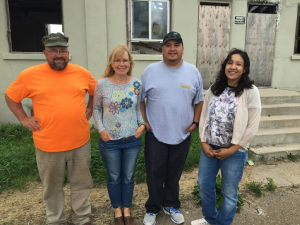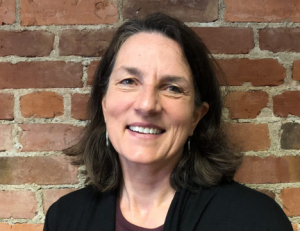By Nedra Chandler & Diana Hammer

There they were: in a bright, spacious room at Tribal Headquarters on a February day, a group of 14 individuals gathered to discuss the burned, abandoned properties in downtown Poplar, Montana. Prior to this meeting, a readiness check process (aka situation assessment) had been conducted to ensure that the right people showed up to the meeting and that the meeting had a clear purpose. The assessment had included contacts with the Tribal Chair and members of the Council. Here at the meeting, one by one, the individuals present from Tribal, federal, state & local government, and broader community interests shared their own world views and perspectives about the many aspects of what they were experiencing related to these burned out properties. And then they were all asked the question: “What are you learning that you want to put into action here?”
Midway into the 4-hour meeting, this group stood together in a relaxed-yet-alert half circle around a board with maps in front of them. They had created another big board with key points that each participant had written up individually, and as they conversed and discussed with one another, they moved these ideas around and began to cluster their points into shared categories of insights and agreed upon the next steps.
Get notified when new articles are posted to the EDR blog – sign up for our email list »
When it was time to check to see if there was agreement among this group that had been empowered to act, one of the key decision-makers looked up in some amazement and said, “We’re not just on the same page here; we are all one.”
At that point, I am sure some of us wondered what would happen next: Was there shared agreement on the path they had just set together? Would anyone re-frame or back away from what had just been summed up? But instead, all 14 individuals agreed whole-heartedly and expressed a genuine acceptance.
What made this possible? Why here, why now, when so many other initiatives don’t go that way? Today, we say “readiness checking.”
At root, the reason to carry out readiness checking again and again—a reason to get really practiced at it—is so that the people involved can have evocative, lower-stakes conversations which help them each discover for themselves: 1) what do they want? 2) what does the situation need? and 3) what seems possible now? The readiness conversations, in themselves, are an important learning opportunity no matter what the result—whether the situation is ripe for collaboration or not.
Here’s the thing: people, conflict situations or other messy public decisions are always ready for something. The overarching questions are what and how. The imperative of readiness checking is to help potential participants question assumptions and slow down long enough to prepare for a deliberate path forward.
Diana Hammer, the EPA lead staff for the “Making a Visible Difference” initiative on the Fort Peck Indian Reservation, recalls the success of that first meeting:
Diana Hammer (HD): “After that situation assessment, we had the most engaging, productive half day I’ve ever spent in a meeting. Now I know that can happen when you take the time up front to prepare, to get the right people together, with good information, who have the best reasons to be there, talking to each other. We were ready.”
HD: “I think we had such a good success starting further back partly because EPA entered this opportunity with their own kind of readiness checking – looking around and asking a lot of people from Fort Peck Tribes and the town of Poplar whether they might be interested in jointly pursuing some joint project that could make a real difference to them, and if so, what? We heard loud and clear the shared interest in removing burned properties that had become a lead and asbestos health hazard in downtown Poplar. In addition, many expressed a local desire to “address redevelopment in beautiful ways.” Later the intention to use beauty took form, such as the plantings in vacant lots to provide shade for community outdoor meeting spaces.”
HD: “By the time we got your impartial help to do a situation assessment, we had heard and acknowledged the various partners’ capacity and resources, and asked ourselves too: Do we want to engage with this right now? Is there enough interest and attention to complete this? It turns out, there was!”
HD: “As I remember it,” Hammer said, “there was no posturing in that first meeting. What I heard was authentic conversation, as you say, ‘listening to learn, and listening as partners’ rather than rushing to fix. We let each other know: here’s what we see, here are our resources. We asked ourselves, so now what needs our shared attention around these properties and the potential for community spaces?”
That small group which met for the first time over three years ago, accomplished something tangible primarily by trusting their partnerships with one another. In spite of the myriad of distractions, they jointly defined the building removal process, completed that technical work in a matter of months, and then set to work on the longer process to conceive and design the redevelopment of community spaces “with beauty” as community members had expressed their hopes earlier. Specifically, a community park on a vacant lot and a ‘splash park’ (designed by working with landscape architecture students from Montana State University and engineering students at Carroll College).
The work of community organizing, tribal, federal, state and local public governance, and administration doesn’t ever really end. But significant working relationships do come from and continue still today for the Fort Peck Tribal government leaders and staff for brownfields, housing and environmental departments, the Cities of Poplar and Wolf Point, the Great Northern Development Council and the State of Montana as they “listened to learn, and listened as partners” on that February morning.
Note: We appreciate the earlier influence and previous review and acceptance of key parts of this blog from Ashleigh Dupree-Weeks, Wilfred Lambert, and Shane Halvorson.
 Nedra Chandler is the associate director of the Stegner Center’s Environmental Dispute Resolution Program. Since 1990 she has mediated or facilitated more than 300 complex environmental and public policy conflicts in the western U.S. and nationally. She has a Master of Arts in geography from the University of Washington and a graduate certificate in public health from University of Montana. Nedra is a credentialed Associate Certified Coach through the International Coach Federation; a mediator on the U.S. Institute for Environmental Conflict Resolution’s National Roster of Conflict Resolution Professionals and Native Network; and a seasoned third-party workshop designer and facili-trainer.
Nedra Chandler is the associate director of the Stegner Center’s Environmental Dispute Resolution Program. Since 1990 she has mediated or facilitated more than 300 complex environmental and public policy conflicts in the western U.S. and nationally. She has a Master of Arts in geography from the University of Washington and a graduate certificate in public health from University of Montana. Nedra is a credentialed Associate Certified Coach through the International Coach Federation; a mediator on the U.S. Institute for Environmental Conflict Resolution’s National Roster of Conflict Resolution Professionals and Native Network; and a seasoned third-party workshop designer and facili-trainer.
 Diana Hammer is a trained and Certified Biomimicry Professional and former Life Scientist with the US Environmental Protection Agency. She founded ReGenerous Cities, LLC and works to create more resilient communities in a changing climate. During her time with the EPA, she worked to restore and redevelop contaminated landscapes and to address environmental challenges in Indian Country. She studied environmental science at Macalester College (B.A.), earned a Master’s in Public Health (Johns Hopkins), and a Master’s of Science (Arizona State University) in Biomimicry. She can often be found out exploring public lands and waters.
Diana Hammer is a trained and Certified Biomimicry Professional and former Life Scientist with the US Environmental Protection Agency. She founded ReGenerous Cities, LLC and works to create more resilient communities in a changing climate. During her time with the EPA, she worked to restore and redevelop contaminated landscapes and to address environmental challenges in Indian Country. She studied environmental science at Macalester College (B.A.), earned a Master’s in Public Health (Johns Hopkins), and a Master’s of Science (Arizona State University) in Biomimicry. She can often be found out exploring public lands and waters.
